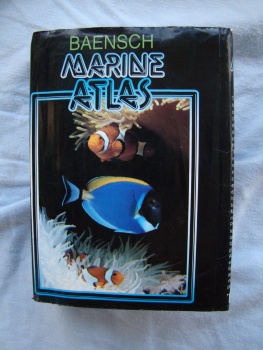
By Bob Goemans

TITLE: Marine Atlas
AUTHORS: Helmut Debelius & Hans A. Baensch
PUBLISHER: Mergus
ISBN 1-56465-113-4
PAGES: 1215
PRICE: $69.95

That's right, one thousand, two hundred and fifteen pages! Well over 1000 excellent color photographs and hundreds of drawings! Simply one of the most comprehensive books you'll ever have the pleasure of reading. Filled with information and photos that have taken decades to assemble.
The book contains eight extensive sections. The first is dedicated to "The Aquarium." It provides direction on equipment choices; data on invertebrate, fish, and combination aquariums; discussion on the basic algae scrubber; technical equipment and system data; choosing a tank; the bottom substrate; and, aquarium background/decoration. Section two pertains to "Water." It discusses seawater; sea salt; composition of seawater; water treatment, i.e., reverse osmosis and ion exchangers; and, salinity. The third section, is entitled "Technology." It reviews water treatment in the aquarium; biological filtration, i.e., aerobic filters, anaerobic filters, and algae scrubbers; external trickle filters; filtration media, i.e. synthetic filter materials, and natural filter materials; water movement; pumps; chemical-physical water treatment, i.e., foam fractionation, ozone, activated carbon, the diatom filter, ultraviolet radiation/sterilization lamps, ion exchangers in the aquarium, CO2 fertilization/calcium reactor, temperature control; illumination, i.e., quantification of light intensity, light hoods, fluorescent tubes, required wattage, mercury vapor lamps, metal halide lamps, personal safety, actinic blue light, and, photoperiod. The forth section is devoted to "Chemistry." It begins with a discussion on nitrogen, i.e., nitrification and denitrification; then proceeds to phosphate; silicon/silicon dioxide/silicic acid; copper; trace elements; the buffering system in marine water, i.e., pH, carbonate hardness, calcium, and, calcium water(Kalkwasser); REDOX potential; yellow pigments; analysis(tests); and finally controllers. Section five is devoted to "Setting Up/Care." It discusses setting up and stocking an aquarium; acclimating fishes; if fishes do not eat; feeding technique; foods, i.e., artemia salina, brachionus, flake food, plant food, feeding stones, frozen foods, freeze-dried foods and liquid foods; adding minerals/trace elements/vitamins; catching your fishes in the aquarium; controller maintenance and care; maintenance activities; the aquarium during vacation; practical techniques; maintenance checklist; unwanted guests; fish diseases, i.e., external parasites, bacterial diseases, fungal diseases, viral infections, diseases from sporozoans and protozoans; and, worms and crustacea. The next section is entitled "Algae." It begins with the taxonomy of algae, and discusses cyanobacteria, blue-green algae, flagellates, red algae, and green algae. The portion on Caulerpa is absolutely the best I've ever seen. It is loaded with color pictures of just about every type of Caulerpa there is! In fact, I saw variations I have never before seen!
You would think by now that you are almost through the entire book. Not so, as you are only a fifth of the way through this massive book. Section seven is devoted to "Invertebrates." It begins with the taxonomy of sea anemones and then moves into identifying various different species of anemones including tube anemones, colonial anemones and false corals. Section seven also includes the taxonomy of crustacea, and includes various shrimp, lobsters and crabs. Keep in-mind that each specimen is identified with a color photo and a complete description noting scientific name, common names where possible, where it comes from, how deep it is found, light requirements, feeding requirements, reproduction methods, and it's general habitat. The same is true for section eight "Fishes," which will provide information on Perches, Surgeonfishes, Rabbitfishes, Moorish Idols, Wrasses, Parrotfishes, Sea Basses and Groupers, Rock Basslets, Fairy Basslets, Marine Betas, Tilefishes, Hawkfishes, Gobies, Blennies, Mandarin Fishes and Jawfishes. There are 400 color photos dedicated to invertebrate, 50 to algae, and 600 to fishes. The book completes with a Bibliography, General Index, Index of Scientific and Common Names, Picture Credits, and a Table of Conversions.
If this is Volume One, and Volume Two will be about soft corals and Damselfish, I can hardly wait! If you thought the Delbeek and Sprung books was excellent as I did, you'll find this one just as good or even better, and that is saying a lot!
Before I stop raving about this book, it should be noted it has been translated from the original German works and contains references to many products not found, or readily available in North America. Yet, this in no way will effect the quality of information dispensed throughout this fantastic book. Marine Atlas is a MUST for any hobbyist, store owner, or marine aquarium society.